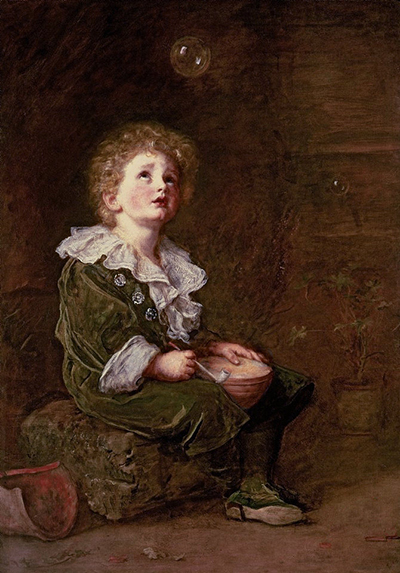Bubbles is one of the most iconic paintings of the Victorian era. Sir John Millais got the idea for the painting from looking at his grandson, and thinking that the beautiful young boy would make an ideal subject for a painting.
He actually used the newly developing science of photography to take a picture of the boy that he could refer to while painting.
Millais had a lot of trouble painting the bubbles because of course, they tend to float off or pop, so in the end he used a glass sphere which could be made to replicate the kinds of reflections that you would get in a soap bubble.
Millais was 57 when he painted this picture in 1886, at the height of his successful career as an artist. Many years previously he had banded together with Rossetti and Holman Hunt to form the Pre-Raphaelite Brotherhood who took their inspiration from Pre-Raphaelite painters, especially in their use of bright colours and intense detail. However this picture shows a much softer approach to the subject with far less vivid colours.
The painting was bought originally by Sir William Ingram who owned the popular periodical the "Illustrated London News". Ingram was clearly a canny operator because he also bought the copyright of the painting and included a colour print of it in an issue of the London illustrated News.
Having done this, he sold the painting in 1887 to the Managing Director of the Pears soap company, who ensured its lasting fame by using it as a soap advertisement, with the Pears soap logo added to it. Millais was not pleased but having sold the copyright, there was nothing he could do about it.
However, like many Victorian paintings, this picture is less sentimental than it might at first appear. The boy in the picture is holding a pipe and a bowl with the soap mixture in it, and is looking up wistfully at the bubble above his head.
The bubble was well known as a symbol of the short lifespan of human beings. It had a history of being used in paintings known as "memento mori", works which sought to remind people that human life was a brief interval, followed by death.In fact, there is a Dutch work by Jan Steen which has a little boy in the background who is both blowing bubbles and clutching a skull.
Many of Millais's paintings have symbolic references to death. However, like many of the greatest artists, he could produce work that was widely acceptable and popular with the public, while including a more profound message for those willing to appreciate it.




